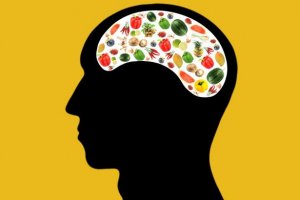7 nutrition rules for vasoconstriction for their expansion, based on science
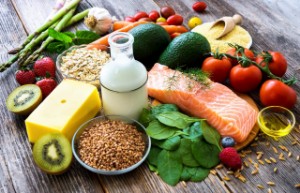 With age, due to an unhealthy lifestyle and poor ecology, the arteries, veins and capillaries of any person begin to work worse.
With age, due to an unhealthy lifestyle and poor ecology, the arteries, veins and capillaries of any person begin to work worse.
First of all, they become clogged, narrow, which leads to hypertension, atherosclerosis, and eventually may result in a heart attack or stroke of the brain.
Therefore, in addition to emergency medical treatment, it is necessary to change the nutrition system in a timely manner so that products that supply nutrients to the body also contribute to constant cleansing and vasodilation.
Modern research confirm the significant role of nutrition in the treatment of hypertension.
Recall that earlier we considered15 vasodilating drinks .
7 general diet rules
Problems with veins and arteries can occur not only in old age, but also in young people. To prevent this from happening and to prevent vasoconstriction, you need to know the general principles of nutrition, Based on scientific research , and start following them, even if the stage of the disease is small or a health problem is just on the way.

- Exclusion of fatty, smoked, high-calorie foods in the diet. An increase in the caloric content of food entails an excess of nutrients in the blood, including fats. Following this, cholesterol begins to be deposited on the walls of the arteries, clots appear in the veins, the lumen of the bloodstream narrows, the walls of the vessels become brittle and inelastic.
- Alcohol exclusion. Strong and even light (and in some cases it is even more dangerous) alcohol that is not consumed in a medical dosage (more than 30-50 g per day) is extremely dangerous. Even a single use of it can lead to spasms and further to the most tragic consequences.
- Healthy basic diet. The base of the diet should be vegetables, herbs, fruits and cereals. This is useful not only because it helps to keep the calorie content of food low. Most herbal products help clean the vessels and protect the body from harmful cholesterol, dissolve and remove old fat deposits from the body.
- Seafood and fish. Oily fish, kelp and other seafood must be on the table of a person prone to atherosclerosis. Because they contain polyunsaturated fatty acids, such as foods are extremely beneficial for vascular health .
- Fractional meal. Frequent consumption of food in small portions improves digestibility, prevents the deposition of fats in the body, the appearance of excess weight, relieves excessive stress from blood vessels.
- The use of folk remedies. In folk medicine, there are many recipes for the preparation of medicinal teas , infusions , infusions and heart mixtures , which are prevention and treatment. Their use will help prevent the occurrence of atherosclerosis and hypertension in general.
- Usage enough water . To maintain normal blood composition and metabolism, you need to drink at least 2 liters of plain water. Otherwise, the blood becomes viscous, clots and blood clots form, blood flow is disrupted and hypertension appears.
Vasodilator Food — Top 10 Foods
Many products, primarily of plant origin, have a certain effect on blood vessels. Knowing these properties will allow you to maintain blood pressure in a normal state, and the walls of the bloodstream can easily expand under the pressure of blood flow. Below we will briefly list products that expand blood vessels .
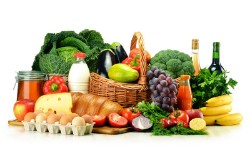
- Vegetables. You need to make vegetables the base of the entire diet. Beetroot , all kinds of cabbage, onions, garlic , pumpkin , tomatoes, zucchini, chili, cayenne and bell peppers, consumed daily, maintain normal vascular tone, allowing them to expand in their natural needs.
- Bread. It is difficult to imagine modern man's food without it. But in order for the arteries and veins to remain healthy, it must be whole grain. Such vasodilating food contains a large amount of fiber, minerals and vitamins. All this complex helps to remove toxins from the body, prevents the deposition of fats.
- Cereals. For the reasons already mentioned, they must also be present in the daily diet. B vitamins provide relief from stress and cramps. Porridges, casseroles and desserts are prepared from oats, buckwheat, millet, rice, barley, wheat, corn, which improve metabolic processes and help reduce blood pressure.
- Fresh or frozen sea fish , seafood and seaweed. All these foods contain Omega-3 and Omega-6 fatty acids, which nourish the cardiovascular system. Normal functioning of arteries and veins is impossible without them. Kelp helps the liver in the production of proper cholesterol, normalizes blood pressure.
- Lean poultry and beef. Animal protein is necessary for the body, but without excess fat.
- Fruits, dried fruits and berries. Garnet , apples, pears, apricots, strawberries, raspberries, kalina , mountain ash , blueberries, raisins , dried apricots , figs help to normalize cholesterol in the blood and reduce the tone of the cerebral vessels by producing nitric oxide in the blood, which dilates the arteries.
- Greenery. Almost any greens contain substances that are vital for the cardiovascular system.
- Unrefined vegetable oils, seeds, nuts. The kernels of seeds and nuts contain a large amount of substances that support arteries and veins in a working condition. If there is a tendency to varicose veins of the legs, especially it is useful to eat walnuts and almonds.
- Green tea. It is known that green tea dilates blood vessels . This drink is a recognized remedy for lowering blood pressure, cleaning blood vessels that cannot expand in the presence of cholesterol deposits on their mucous membrane.
- Medicinal herbs. As part of the collections for vasodilation, there may be such useful herbal remedies as motherwort, mistletoe, ivan tea, valerian, birch buds, chamomile, hazel, hawthorn.
What should be avoided?

- Butter. Even an elderly person should not be completely deprived of this product: butter contains vital vitamins and other organic substances. But it should be consumed in the most minimal amounts &8212; 10-15 g per day. The rest of the fats in the diet should be vegetable. Do not forget that there are also oils that are useful for blood vessels .
- Fatty dairy products. Fatty whole milk is very difficult to find in the store. But fatty dairy products are in abundance. These are yellow cheeses, which indicates a high fat content, cream, sour cream in large quantities, too fatty cottage cheese (18%), etc. All these products also contain animal fats, which complicate digestion and provoke narrowing of the peripheral and blood vessels of the brain.
- Lard, fatty meat. Animal fats in lard, pork, lamb, fatty poultry, offal &8212; are a source of a lot of energy. But they are dangerous because they are poorly absorbed, and fat is deposited on the internal organs, provoking the destruction of the walls of blood vessels, disrupting the possibility of their natural expansion.
- Strong meat broth. It contains fats and other substances in concentrated form that thicken the blood, preventing its normal flow and interfering with the free expansion of blood vessels.
- Canned food. Canned fish contains a lot of fats, which provoke the appearance of bad cholesterol in the blood and reduce the elasticity of the arteries. Canned vegetables contain a lot of salt and preservatives
- Fried potatoes. Despite the fact that it is a vegetable, it belongs to starchy foods, the digestion of which is difficult. And when fried, it forms a large number of carcinogens that clog the blood and blood vessels. In addition, it contains an unacceptably large amount of fat, as it absorbs any oil very well.
- Ready-made sauces. Soy sauce contains a huge amount of salt, which changes the composition of the blood and does not allow the vessels to relax. Mayonnaise and cream sauces are bad because they contain a lot of salt, preservatives, but most importantly &8212; unnecessary fats, which increase the level of &171;bad&187; cholesterol, which is easily deposited on the walls of arteries.
- Sweets and sweet pastries. Cakes, pastries, buns, cookies, candies and other sweets, &8212; almost everything that is produced industrially increases the level of sugar and fats in the blood, makes blood vessels brittle, permeable and inelastic, prevents their normal expansion.
- Strong coffee, cocoa, tea. These are conditionally prohibited products, since they are harmful to blood vessels only when they are tightly brewed. For example, medium-strength coffee does not provoke spasms, but on the contrary, prevents atherosclerosis, and therefore ultimately supports the elasticity of the arteries. More detailed about the effect of coffee on blood vessels See in a separate article.
- Alcohol abuse. Despite the fact that almost any alcoholic beverages dilate blood vessels, those diagnosed with hypertension cannot use alcohol. Alcohol of any strength guarantees an increase in pressure and a decrease in the elasticity of the walls of the bloodstream. Alcoholic beverages can only be used for prevention or on a one-time basis, as a temporary measure, and in very limited quantities (50-150 for low-alcohol, 30-70 for strong drinks).
Also check out the infographic:
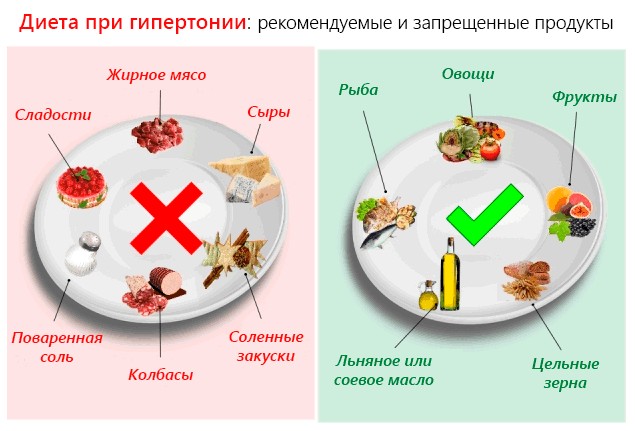
What about alcohol?
Is it possible to drink alcoholic beverages?
Alcohol has a vasodilating property . But only at the first moment: this is followed by a jump in blood pressure and a spasm if the dose is exceeded. Therefore, it is advisable to use it as a preventive measure, in a very limited volume, in order to achieve a vasodilating effect without further increase in pressure and narrowing of the arteries.
Consider the most popular:
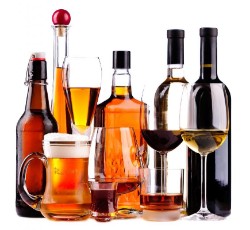
- Wine . Natural white, and especially red wine, are famous for improving blood composition, purifying the bloodstream and strengthening the walls of arteries and veins, making them more plastic and impenetrable. But such an effect is possible with regular use of 50-150 g 2-3 times a week, and for prevention, not for the treatment of existing problems.
- Cognac . This drink perfectly expands the vessels of the head. In addition, after being aged for a long time, it acquires many useful properties. But they work only if its consumption does not exceed 30-70 g, depending on the state of health and age of the person.
- Vodka . The drink is strong and has the least therapeutic effect: it only dilates blood vessels, and only at the first moment. The dosage of 30-50 g is almost never observed, therefore, with each subsequent gram, the arteries narrow.
- Beer . One of the most harmful alcoholic beverages for arteries and veins. It is never drunk at 50-150 ml, which means that it will have practically no vasodilating effect. On the contrary, drinking beer is accompanied by fluid retention in the body, edema, stress on blood vessels and heart muscle. In addition, the kidneys, which cannot cope with the volume of beer consumed, produce vasoconstrictors in addition to the vasoconstrictive effect of ethyl alcohol.
Conclusion
It is not difficult to make a vasodilator menu. For good elasticity of veins and arteries, it is enough to exclude excess salt, fats, food with preservatives from the diet and introduce vegetable dishes and healthy animal products into the diet. Such eating habits will improve not only the cardiovascular system, but also all body systems.

